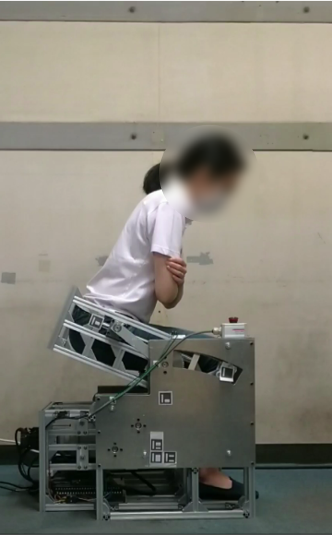高井グループの研究概要
人が運動を習得する仕組みを理解し、その習得を手助けする、運動学習支援ロボットおよび支援システムについて研究しています。
We are researching motor learning support robots and systems designed to facilitate the acquisition of motor skills by understanding the mechanisms of human motor learning.
概要:
パワーアシストロボットに代表される運動支援ロボットが、最近多くの注目を集めています。人の足りない力を補ったり、そもそも人が運動する必要性を減らす省力化を実現できることがメリットと考えられています。
一方で、高齢者はむしろ運動量を増やす必要があったり、神経疾患や骨折などでリハビリテーションが必要な患者にとってはアシストしすぎも駄目で、手助けすることとご自身で頑張っていただくことの良いバランスが必要と言われています。つまり、やみくもに負荷を上げてしまうと、逆効果なのです。身体への負荷が適切に調整された運動を体感してもらって、良い運動を習得してもらいたいと考えています。そこで必要になってくるのが、高井グループで研究している運動学習支援ロボットおよび支援システムです。このような運動学習支援ロボットおよび支援システムを開発するには、いくつかわからない事が存在します。
Overview:
Recently, motor assist robots, represented by power assist robots, have attracted attention. The advantage is that assist robots can be used to supplement the strength that a person lacks or to save labor so that the person does not have to exert any force in the first place.
However, in the case of elderly people, it is preferable for them to exert some effort rather than relying entirely on assistance. Similarly, in the case of people who need rehabilitation due to neurological disorders or fractures, there is a need to maintain a good balance between assisting and working hard by themselves. I think it would be good for them to experience movements in which the physical load on their body is appropriately reduced and to learn how to reproduce such movements by themselves. What will be needed is the motor learning support robots and systems, which is our research.
解決したい課題1:
1つには、ロボットと人が力の次元でお互いに影響しあう、力覚インタラクションが複雑で数式化しにくく、またどのような特徴を持った力覚インタラクションが良いのか明らかになっていないことです。
例えば、今開発している起立支援ロボットは、人の臀部を座面で押して起立を手助けします。この押す力を個人に合わせて調整したい時、このような時はこの値で、という相関を決めるアルゴリズム開発が必要となります。しかし、足部と臀部の両方から力のやり取りがあるので、一つに決めることが困難です。

座る位置や上半身の傾き、立ち上がる速さなどによっても、力のインタラクションは変わってきます。そこで、現時点では2つのアプローチでアルゴリズム開発に取り組んでいます。一つにはディープラーニングを使った手法、もう一つは物理モデルを使った手法です。
そのように力のインタラクションそのものを推測する事と同時に、人の反応や動き方の変化も推定を試みています。自力で椅子から立ち上がる動きと、座面に押されて立ち上がる動きは、当然違ってきます。また、初めて押された時と、2回目でも立ち上がり方は違ってきます。この立ち上がり方の変化は、人によって違うのか、何か傾向があるか、明らかにしなければなりません。加えて、押されて立ち上がる事に慣れた後に、急に押されなく無くなったら、次はどのように立ち上がり方が変わるのか、予想できている方が良いです。
このような知見を貯めて行く事で、高齢者ならばどういう押し方をするべきか、患者であれば、どういう押し方をすれば、いつまでにどのような身体機能を回復させられるか見当が立ちますし、目標として設定する事ができます。
関連する発表:
・高井 飛鳥, 裴 凱強, 新谷 篤彦, 川合 忠雄, ”Modelica モデルを用いた起立支援装置の移動機構部の設計”, 日本機械学会 2022年度 年次大会, https://doi.org/10.1299/jsmemecj.2022.J162-08
・高井飛鳥、音森直人、小澤海斗、鈴木雄太, "起立支援装置の支援軌道と支援速度の評価", 日本機械学会 関西支部 第99期定時総会・講演会
・Naoto Oromori, Asuka Takai, ”Long Short-Term Memory (LSTM) Estimation of Chair Reaction Force during Sit-to-Stand Movements”, 2023 23rd International Conference on Control, Automation and Systems (ICCAS), Yeosu, Korea, Republic of, 2023, pp. 472-477, doi: 10.23919/ICCAS59377.2023.10317053.
Research Topic 1:
One of our challenges is that haptic interactions, where robots and humans influence each other in the dimension of force, are complex and difficult to quantify, and it is not clear what kind of characteristics haptic interactions have.
For example, the standing-up support robot we are currently developing helps people stand up by pushing their buttocks via the seat. To adjust this pushing force to suit the individual, an algorithm that determines the correlation, such as using a certain amount of support at a certain time, is necessary. However, since forces are exchanged from both the feet and buttocks, it is difficult to decide the amount.
The interaction of forces changes depending on the sitting position, the tilt of the upper body, and the speed at which one stands up. Therefore, we are currently working on algorithm development using two approaches: machine learning and a physical model.
In this way, while estimating the interaction of forces, we are also trying to estimate changes in people's reactions and movements. Naturally, the movement of standing up from a chair on one's own and the movement of standing up while being pushed by the seat are different. Also, how one stands up will be different the first time it is pushed than the second time. We need to clarify whether this change in how people stand up differs from person to person or whether there are any trends. In addition, it is better to be able to predict how the next time one will stand up if one gets used to being pushed and then suddenly stops being pushed.
By accumulating this knowledge, we will be able to get an idea of what kind of pushing should be used for elderly people and what kind of pushing should be used for patients to recover what kind of physical function by when, as they can set a goal.
解決したい課題2:
また別の疑問として、「運動を良くするためには、どのような情報をその人に伝えるべきか」、と考えています。
今開発しているのは、視覚情報、特に仮想現実を利用した支援システムです。私たちが自分の身体を見る時は一人称視点ですが、他者から運動を教えてもらう時や動画を見て真似をする時などは三人称視点です。どちらの見え方が、どの動きの習得に有益なのか、調べる必要があります。
ここで、仮想空間技術の良い所は、アバターに運動させて、視点を自由に変えて見ることができることがあげられます。マーカーを付けて情報を増やしたり、よりアバターが自分だと思える状況と自分だと思えない状況も作り出し比較することもできます。
色々な条件を実験して、力のインタラクションの場合と同様に、人の運動の変化を計測する事で、視覚情報の使いどころを見つけたいと考えています。そうすることで、より多くの人に、必要な運動の仕方を教えられるようになることを目指しています。
関連する発表:
・松宮 光照, 高井 飛鳥, ”仮想空間上に存在するアバターが⾏う動作の観察による運動学習の提案”, 第4回日本再生医療とリハビリテーション学会学術大会, https://system.mech.kyushu-u.ac.jp/jsrmr2022/presen.html
・松宮 光照, 高井 飛鳥, ”バーチャルリアリティを⽤いた遅延視覚が的あてゲームの成績に与える影響に関する研究”, 日本機械学会 シンポジウム:スポーツ工学・ヒューマンダイナミクス2023(SHD2023)
Research topic 2:
What kind of information should be conveyed to the person is important in order to improve the movement.
What we are developing now is a support system using virtual reality.
The merit of virtual reality is that you can have an avatar conducting a movement and arbitrarily observe it from the first-person or the third-person perspective.
We aim for a system that can provide visual information to teach people how to move in a better way for those who can learn more efficiently through visuals.
解決したい課題3:
もう一つ、取り組んでいる内容として、脳活動を活用した支援システムがあります。
運動する時などの能動的な状況や、音が鳴ったというような受動的な状況でも、その事象に応じた脳の活動が生じます。このような事象に関連する脳の活動が存在する事は広く研究されており、「ブレインロボットインタフェース」と呼ばれる、脳の活動を捉えてロボットを動かす活用方法も提案されています。
高井グループで今取り組んでいるのは、事象に関連する脳活動の個人ごとの特徴と、その特徴の変化の調査です。運動にかかわる情報に対する脳の反応や、注意機能を評価することができれば、その人にあった情報を伝えられて、より効率的に機能の向上を図れることを期待しています。
関連する発表:
・片岡 悠, 高井 飛鳥, ”力覚提示インターフェースによる運動教示時の脳波と運動学習効果の関係に関する研究”, 第20回日本神経理学療法学会学術大会, http://jsnpt20.umin.jp/images/jsnpt20_program-2.pdf
・片岡 悠, 高井 飛鳥, ”知覚能力を考慮した力覚インターフェースによる運動教示学習時の脳波と学習効果の関係に関する研究", 第10回日本BMI研究会
Research topic 3:
Another thing we are working on is a support system using brain activity.
By capturing brain activity and controlling the robot accordingly, we aim to efficiently improve motor functions.
今後の展開:
将来的には、年齢や障害に関係なく、いつでも高い運動機能を維持できるように、一人一人にあった運動学習支援ロボットおよび支援システムを実用化したいと考えています。
そのためには、家庭で使える物も必要でしょうし、病院や介護施設などで使っていただける物も必要になってくると思います。医師や看護師、理学療法士や作業療法士など、それぞれの現場の専門職の方々と連携して、多くの実験データを集めたり、必要となる機能を協創していきたいと考えています。
もちろんロボットやシステムを万能にすることはできないので、ロボットやシステムならではの機能を持たせることで、専門職の方々がより高度な技術を高齢者や患者に提供できるようになる使われ方を目指して研究開発を進めたいと思っています。
Plans:
I want to implement unique functions that can only be realized by robotics and systems with the aim of developing our robots and systems that can support doctors and therapists can providing advanced professional skills to the elderly and patients, promoting better motor learning and re-learning.
I want to realize a contrivance that allows us to capture and improve our motor function at any time, which is being implemented in society everywhere. It is a kind of system where you can measure and grasp changes in your motor function, receive diagnoses, and even receive recommendations on what kind of training you should do. It should be used at home and might look like and be as convenient as a smartphone.
I aspire to realize the practical application of the motor learning support robots and systems tailored to each individual so that they can maintain a high level of motor function at any time, regardless of age or disability.
I am imagining a world where everyone can lead their lives without inconvenience.